CBSE Class 12 Physics Chapter 7 Alternating Current notes in PDF are available for free download in myCBSEguide mobile app. The best app for CBSE students now provides Alternating Current class 12 Notes latest chapter wise notes for quick preparation of CBSE board exams and school-based annual examinations. Class 12 Physics notes on chapter 7 Alternating Current are also available for download in CBSE Guide website.
CBSE Guide Alternating Current Class 12 Notes
CBSE guide notes are the comprehensive notes which covers the latest syllabus of CBSE and NCERT. It includes all the topics given in NCERT class 12 Physics textbook. Users can download CBSE guide quick revision notes from myCBSEguide mobile app and my CBSE guide website.
Class 12 Physics notes Chapter 7 Alternating Current
Download CBSE class 12th revision notes for chapter 7 Alternating Current in PDF format for free. Download revision notes for Alternating Current class 12 Notes and score high in exams. These are the Alternating Current class 12 Notes prepared by team of expert teachers. The revision notes help you revise the whole chapter 7 in minutes. Revision notes in exam days is one of the best tips recommended by teachers during exam days.
Download Revision Notes as PDF
CBSE Class 12 Physics Revision Notes Chapter 7 Alternating Current
Alternating Current: The current whose magnitude changes with time and direction reverses periodically is called alternating current. a) Alternating emf E and current I at any time am given by:
Where,
Where,
Where T is the time period.
- Values of Alternating Current and Voltage
- Instantaneous value: It is the value of alternating current and voltage at an instant t.
- Peak value: Maximum values of voltage E0 and current I0 in a cycle are called peak values.
- Mean or average value of a.c.: It is defined as that value of direct current which sends the same charge in a circuit in the same time as is sent by the given alternating current in its half time period. For complete cycle,Mean value for half cycle:
- Root – mean- square (rms) or effective or virtual value of a.c.: It is defined as that value of direct current which produces the same heating effect in a given resistor as is produced by the given alternating current when passed for the same time.RMS values are also called apparent or effective values.
- Phase difference Between the EMF (Voltage) and the Current in an AC Circuit: A diagram that represents alternating current and voltage of the same frequency as rotating vectors (phasors) alogwith proper phase angle between them is called a phasor diagram.
- For pure resistor: The voltage and the current are in same phase i.e. phase difference
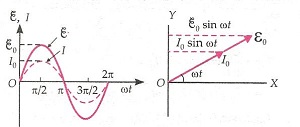
- For pure inductor: The voltage is ahead of current by i.e. phase difference
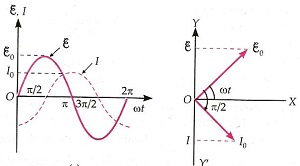
- For pure capacitor: The voltage lags behind the current by i.e. phase difference
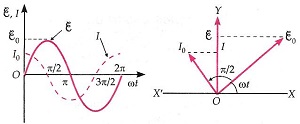
- Reactance: The non-resistive opposition to the flow of a.c. is called reactance.
- Impedance: It is defined as the effective resistance of the series LCR-circuit which opposes the flow of current through it is called impedance, Where is the phase difference of the voltage E relative to the current I.
- For L – R series circuit:
- For R – C series circuit: Or
- For L – C series circuit:
Or
- Conductance: Reciprocal of resistance is called conductance.
- Power in an ac circuit:
- Electric power = (current in circuit) x (voltage in circuit)P = IE
- Instantaneous power:
- Average power:
- Virtual power (apparent power):
- Power Factor: It is defined as the ratio of the true power to the apparent power of an a.c. circuit.
- For purely resistive circuit-
- For purely inductive or capacitive circuit-
- For LCR circuit-
- Wattless Current: The component of current differing in phase by relative to the voltage, is called wattles current.
- The rms value of wattless current:
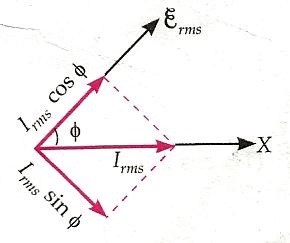
The component is called wattless current because it does not consume any power in a.c. circuit.
- Choke Coil:
- An inductive coil used for controlling alternating current whose self- inductance is high and resistance negligible, is called choke coil.
- The power factor of this coil is approximately zero.
- It controls current without consuming any power.
- Series Resonant Circuit
- When the inductive reactance (XL) becomes equal to the capacitive reactance (XC) in the circuit, the total impedance becomes purely resistive (Z = R).
- In this state, the voltage and current are in same phase ( = 0), the current and power are maximum and impedance is minimum. This state is called resonance.
- At resonance, Hence, resonance frequency is,
- In resonance, the power factor of the circuit is one.
- Half – Power Frequencies: Those frequencies f1 and f2 at which the power is half of the maximum power (power at resonance), i.e., f1 and f2 are called half – power frequencies.
- Band – Width:
- The frequency interval between half – power frequencies is called band – width.
- For a series LCR resonant circuit,
- Quality Factor (Q): It is defined as the ratio of the resonant frequency to the difference in two frequencies taken on both sides of the resonant frequency such that at each frequency, the current amplitude becomes times the value at resonant frequency.
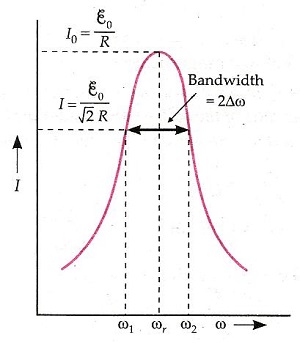
- LC-Oscillations:- When a charged capacitor is allowed to discharge through a non-resistive inductor, electrical oscillations of constant amplitude and frequency are produced. These oscillations are called LC-oscillations.
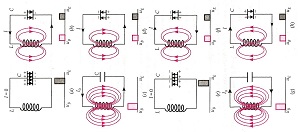
- Transformer:- It is an electrical device for converting an alternating current at low voltage into that at high voltage or vice versa.
- If transformer increases the input voltage, it is called step-up transformer.
- If transformer decreases the input voltage, it is called step-down transformer.
- It works on the principle of mutual induction, i.e. when a changing current is passed through one of the two inductively coupled coils, an induced emf is set up in the other coil.
- Energy losses in transformers-
- Copper losses
- Eddy current losses
- Hysteresis loss
- Flux leakage
- A.C. Generator:- It is a device which converts mechanical energy into electrical energy.
- Principle: It is based on the principle of electromagnetic induction.
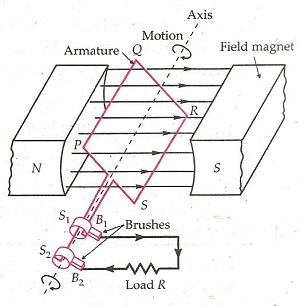
CBSE Class 12 Revision Notes and Key Points
Alternating Current class 12 Notes. CBSE quick revision note for class-12 Physics, Chemistry, Math’s, Biology and other subject are very helpful to revise the whole syllabus during exam days. The revision notes covers all important formulas and concepts given in the chapter. Even if you wish to have an overview of a chapter, quick revision notes are here to do if for you. These notes will certainly save your time during stressful exam days.
- Physics
- Chemistry
- Mathematics
- Biology
- Accountancy
- Economics
- Business Studies
- Computer Science
- Informatics Practices
- English Core
- History
- Physical Education
To download Alternating Current class 12 Notes, sample paper for class 12 Physics, Chemistry, Biology, History, Political Science, Economics, Geography, Computer Science, Home Science, Accountancy, Business Studies and Home Science; do check myCBSEguide app or website. myCBSEguide provides sample papers with solution, test papers for chapter-wise practice, NCERT solutions, NCERT Exemplar solutions, quick revision notes for ready reference, CBSE guess papers and CBSE important question papers. Sample Paper all are made available through the best app for CBSE students and myCBSEguide website.
- Electric Charges and Fields class 12 Notes Physics
- Electrostatic Potential and Capacitance class 12 Notes Physics
- Current Electricity class 12 Notes Physics
- Moving Charges and Magnetism class 12 Notes Physics
- Magnetism and Matter class 12 Notes Physics
- Electromagnetic Induction class 12 Notes Physics
- Electromagnetic Waves class 12 Notes Physics
- Ray Optics and Optical class 12 Notes Physics
- Wave Optics class 12 Notes Physics
- Dual Nature of Radiation and Matter class 12 Notes Physics
- Atoms class 12 Notes Physics
- Nuclei class 12 Notes Physics
- Electronic Devices class 12 Notes Physics
- Communication Systems class 12 Notes Physics

Test Generator
Create question paper PDF and online tests with your own name & logo in minutes.
Create Now
Learn8 App
Practice unlimited questions for Entrance tests & government job exams at ₹99 only
Install Now